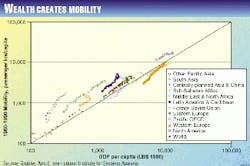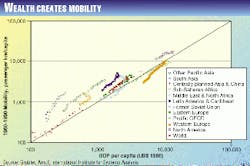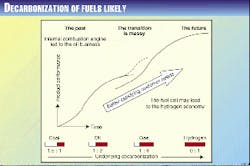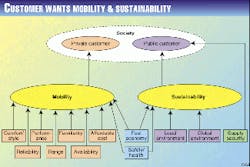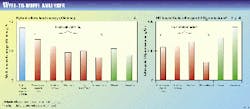Fuel-cell vehicles offer clean and sustainable mobility for the future
In the scramble for alternative fuels, the fuel-cell car will likely be the vehicle of future. Advanced internal combustion engine (ICE) vehicles and hybrid vehicles will serve as transitional vehicles until the fuel-cell car is accepted widely.
It is difficult to predict when this will happen and to describe the events until this time. How the future for transportation fuels unfolds, and the speed at which it does so, depends largely on two things: the amount of pressure society exerts and the extent to which each new vehicle eases this pressure.
Despite the good feelings of freedom, speed, and independence that driving stirs, today's driving experience causes several concerns: congestion, inner-city pollution, repair bills, the price of fuel, and handling skills of other road users.
Industry and government alike are tackling the task of reducing or removing the negative aspects of motoring. Players include auto makers, fuel suppliers, road planners, and legislators.
Although much could be written about the various choices for alternative fuels (comprising liquefied petroleum gas, compressed natural gas, liquefied natural gas, biofuels, ethanol, methanol, hydrogen, etc.), this article concentrates on advanced ICE, hybrid, and fuel-cell vehicles. Other fuel and vehicle alternatives will likely serve niche markets and not mainstream ones.
Past attitudes to fuel
Before attempting to paint a picture of the future, it should be acknowledged that previous predictions were wrong in both detail and timing of the future for transportation fuels.
The scramble for alternative fuels initially arose from the fear of the depletion of oil reserves. Today, with ample oil reserves, the pressure for change comes from the desire for cleaner air and concern about possible climate change.
The decline and eventual demise of the ICE will not be as a result of the scarcity of oil or the poor performance of the engine itself. Instead, the end of the ICE will come when customers find its alternatives superior.
Historically, "superior" meant greater speed and more comfort. For example, trains moved away from coal and steam-powered vehicles to those fueled by superior diesel and then later, to those fueled by even more superior electricity.
For the future, "superior performance" will not be based on speed and comfort. Rather, it will be based on cultural attitudes towards the car, perhaps triggered by some of the side effects of road transportation.
Reasons for alternative modes
The three principal drivers for alternative transportation fuels arise from the need for: mobility, cleaner air, and sustainability.
For mobility, people prefer to travel by car. As wealth increases, so do the number of cars on the roads. Fig. 1 shows the increased amount of travel per capita in different areas of the world between 1960 and 1990.
Growth in vehicle population tends to slow down when car densities exceed 100 cars/sq km. Locations where limited available road space has impacted the number of cars on the road include Singapore, Hong Kong, Japan, and The Netherlands.
Research shows that, regardless of income, people typically limit their daily travel to around 1-1.5 hr.1 Exceeding this period on a regular basis often results in the abandonment of the car in favor of high-speed trains or planes. In many Organization for Economic Cooperation and Development (OECD) countries people travel some 30,000 km/year, or more than 1.5 hr/day in traffic, which increases localized pollution.
The next generation of vehicles or fuels will not solve traffic congestion. While such vehicles will address concerns about vehicle emissions and air quality, the cure for traffic congestion requires changes in behavior that many people will be reluctant to make.
To solve congestion, information technology will play a leading role when congestion exceeds the public's acceptable limit. It can provide improved traffic management and support more efficient public transport systems. Information technology may also offer "virtual mobility" like e-commerce or video conferencing that will reduce unnecessary vehicle usage.
Activities such as the European Auto-Oil initiative and the Kyoto Climate Change Protocol establish the general direction of tougher future targets for fuel. The European Auto-Oil initiative is specifying stricter vehicle emissions standards and fuel specifications, and the Kyoto Protocol commits industrialized countries to reduce greenhouse gases by 2008-2012.
As emission targets become more challenging, the ICE comes under significant pressure and the move away from carbon fuels becomes accelerated (Fig. 2). Equally, the fact that such industrial and legislative groups exist and publicize their actions raises public awareness about (and creates an expectation for) the options on the horizon.
Factors to success
There are three main factors that will define the commercial success of next generation vehicles:
- Technical feasibility (it must work).
- Appropriate fueling infrastructure (it must keep working).
- Customer acceptance (someone must buy it).
While the majority of today's effort centers on technical feasibility, in reality, all three factors are interrelated and interdependent. The three elements should be developed in parallel.
Since the industrial revolution, periods of major economic expansion have required the development of new infrastructures for the widespread introduction of new products or industrial activity. Transport infrastructures such as canals, railways, roads and airports enabled the benefits of new products and industries to be realized (such as coal, steel and electrification in the case of railways).
Getting the customer to buy the product is the final (and often fatal) hurdle. "Customer acceptance" comprises a complex set of rational and emotional needs and desires (Fig. 3). The reasons why customers prefer one vehicle or fuel option over another needs to form part of the technical and infrastructure development programs as early as practicable.
The possibilities for alternative vehicles seem wider than they have been for decades. In 5-10 years, some of these new vehicles will start appearing on the roads.
History suggests, however, that large-scale replacement of the vehicle fleet (excluding some form of crisis or technological "leap") will take time. Thus, conventional vehicles will coexist with new ones for some time.
Vehicle alternatives
When the right time comes, what will the new vehicles look like?
The three candidates offering the greatest potential for widespread appeal and are:
- Advanced ICE vehicles.
- Hybrid vehicles.
- Fuel-cell vehicles.
The sequence of new vehicle technologies looks set to start with the advanced ICE vehicle and end with fuel-cell vehicle, with considerable overlap and competition along the way.
Almost all the major players in the industry are investing significant amounts of money and manpower in all three options. How well these vehicles compete with the existing mainstream proposition will be vital.
The gasoline-powered ICE is reliable, simple to make, and relatively inexpensive to buy and maintain. Moreover, an efficient fueling infrastructure is already in place.
Alternative fuel and engine technologies will have to effectively challenge the high specific energy densities of the existing liquid fuels (gasoline and diesel). These densities provide the advantage of high mileage between refueling stops.
While it is not possible to do justice to the depth and breadth of effort around the world, several important efforts have furthered the development of fuel cells:
- Partnership for a New Generation of Vehicles.
- California Fuel-Cell Demonstration Initiative.
- Strategic alliances between auto and oil companies.
- New fuel-cell technology companies.
Development of fuels cell vehicles under the Partnership for a New Generation of Vehicles is supported by the US Department of Energy, other federal agencies, and the three largest US car companies.
The California Fuel Cell Demonstration Initiative's members include international auto makers, fuel-cell manufacturers, and oil companies. The organization tests the feasibility of running fuel-cell powered vehicles in California.
Although specific focus and development targets vary between automotive manufacturers and oil companies, strategic alliances between these two groups will speed up the development of hybrid and fuel-cell technologies. These partnerships involve a sharing of expertise and costs, which will help in the development of a common infrastructure to deliver the next generation of fuels.
Finally, the emergence of new (and the expansion of existing) companies developing static and mobile applications for fuel-cell processors and power plants help to quicken the advance of the fuel-cell future.
Advanced ICE, hybrid vehicles
In the short term, advanced ICE vehicles and hybrid vehicles are the most likely transitional vehicles.
The advanced ICE offers improved vehicle performance, speed, reduced environmental impact, and lower cost of ownership.
Indeed, it is unwise to forget the progress made and to ignore the potential impact of these cleaner "conventional" engines on next generation vehicle development. A major auto maker, for example, recently announced the launch of a gasoline car that can produce less pollution over a 20 mile journey than found with a typical new car parked with its engine switched off!
There is clearly still potential for improving the ICE. In its conventional form, the ICE converts only 13-18% of the energy within crude oil into useful propulsion.
Nonetheless, any gasoline or diesel engine will still emit some pollution. In light of that observation, alternatives, such as fuel-cell cars, offer greater longer-term potential. Therefore, improvements to the ICE likely will merely postpone its demise.
Hybrid vehicles, which combine the ICE and electric drive, are an ideal transitional vehicle for fuel-cell vehicles. The combination of engine, engine-management system, and regenerative braking (recovering some of the car's kinetic energy when braking), perhaps allows it to offer the best "well-to-wheel" efficiencies overall (Fig. 4a). Well-to-wheel efficiencies encompass processes from crude extraction to vehicle-fuel consumption.
The hybrid technology has commercial models available from almost all of the major car companies. These vehicles are comparatively complex, however, and are potentially expensive to both build and maintain. The hybrid car will not be viable, if zero emissions become the ultimate target.
Electric vehicles
Whereas a battery-driven electric vehicle is clean at the point of use, it has several limitations, which include "well-to wheel" pollution levels, restricted range, low battery lifetime, and high cost.
The above constraints associated with a battery-powered electric vehicle suggest success in niche market applications only. Fuel cells, on the other hand, offer the advantages of the battery in an electric vehicle, but without its shortcomings. Quietness and potential efficiencies make the fuel-cell option an ideal vehicle for the future, particularly within towns and cities.
In fuel cells, hydrogen is the theoretical ideal fuel. Hydrogen can be reacted in a fuel cell to generate electricity with water as the only by-product.
Hydrogen's physical properties, however, make on-board storage difficult, particularly in a car where storage space is at a premium. Even under pressure, the energy density of the gas is too low to be of practical value in a car. As a liquid, hydrogen requires cryogenic storage that creates high energy losses and needs careful management in enclosed spaces.
The long-term objective for hydrogen fuel in automobiles is to find a way of storing sufficient hydrogen for an adequate vehicle range. This goal requires significant scientific breakthroughs in hydrogen-storage technologies, for example, in hydride or carbon nano-fiber technologies.
Pending such a breakthrough, the alternative is to generate hydrogen within the car itself, extracting the gas from other fuel sources via a reforming process. Several energy sources exist, but the two leading candidates today are methanol and the "light" forms of hydrocarbons (that is, naphtha or gasoline-type fractions).
There are strengths and weaknesses associated with each candidate fuel. There are also divergent views about the commercial viability of methanol in fuel-cell vehicles.
Hydrocarbon-based fuels benefit from the ability to use the existing fueling infrastructure. They also offer good "well-to-wheel" CO2 emissions (Fig. 4b). Hydrocarbon based fuels, because they are similar to current fuels, are more likely to be accepted by the customer than other alternatives (Fig. 5a).
Hydrogen can be extracted more simply from methanol than from its hydrocarbon-based counterparts. The disadvantages with methanol arise because the product is toxic, corrosive, and miscible in water. The corrosive nature of methanol and its solubility in water make it incompatible with all existing service station and fuel distribution infrastructures. Fig. 5b compares the infrastructure of some fuel alternatives.
Caveat for the future
So, the future is one of intense competition and coexistence of vehicle types and fuel options. The phased replacement of the current gasoline and diesel vehicle fleet is already underway with the emergence of improved versions of the ICE.
Such cars will subsequently need to compete with mainstream versions of the hybrid car. In turn, fuel-cell vehicles will eventually challenge these hybrids and perhaps some remaining ICE cars.
Fuel-cell vehicles themselves will undergo an evolution; depending initially on a reformer to generate the hydrogen but finally yielding to direct hydrogen fueling.
Some familiar technologies may disappear in the future, but subsequent generations will likely continue to regard personal transportation as a necessity. The challenge will be to solve present mobility problems without compromising future options.
Whatever the details, change is certain and the alternative transport fuels seem ready to offer clean and sustainable mobility. It remains a possibility that fuel-cell vehicles may fail to become established for everyday transport.
Ultimately, the consumer decides. Without the customer's total confidence (the rational and emotional factors that make the consumer want to buy a car), the sequence of events outlined in this article will not happen.
Reference
- Schafer, Andreas and David Victor, "The Past and Future of Global Mobility," Scientific American, October 1997, pp. 58-61.
The Author
Tim Ford is vice-president for fuels in the marketing group of Shell International Petroleum Co. Ltd. He is responsible for the Shell Group fuels strategy and product development in the short and long term.
He has been with Shell for 17 years. He spent 10 years based outside the UK, including stints in Australia and the Caribbean. In his last position outside of the UK, he served as chairman and managing director of Shell's downstream operations in Oman, from which he returned to the UK in late 1998.
Ford holds a Bsc in material science from the University of Bath, U.K.
